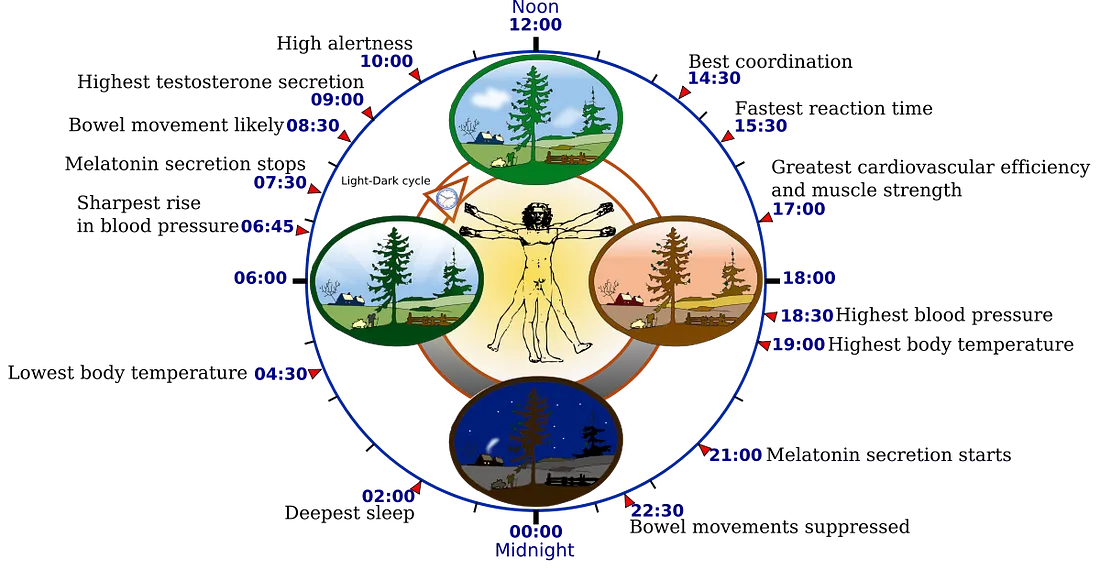Why Your Body Might Be Fighting Against You
Do you ever feel a bit off with your body? Maybe you’re eating healthy but can’t seem to shake the weight? Maybe your body is in constant hunger mode craving the foods that you shouldn’t be eating? Do you have trouble focusing for long periods of time? Can’t seem to control your mood at times? Or perhaps you’re battling periods of low energy throughout the day and can’t seem to find the juice to play with your kids by end of day?
If you said, “Yes” to any one of those it may be time to start taking your Circadian Rhythms seriously.
Understanding Your Body’s Natural Clock
As a wellness coach who has helped clients transform their health, I’ve seen these symptoms repeatedly. The root cause? We’re fighting against our body’s natural rhythm rather than working with it.
The Master Conductor: Your Brain’s Control Center
Your Circadian Rhythms are controlled by a group of nerves in the hypothalamus of the brain known as the suprachiasmatic nucleus, which is also known as your master clock or SCN for short. Think of your master clock as a sophisticated signaling center that responds to environmental cues like light, dark, physical activity, and eating habits.
When certain cues are experienced, your body orchestrates a complex symphony of:
- Hormone releases
- Temperature regulation
- Metabolism adjustments
- Sleep-wake cycles
- Mood regulation
Rhythms in Action
Let me share some real-world examples of circadian rhythms at work:
- Morning Routine: Having a consistent bathroom schedule first thing in the morning isn’t just coincidence — it’s your body’s natural rhythm at work. This automated process signals a well-regulated circadian system.
- Evening Wind-Down: As the sun sets, your body begins its natural preparation for sleep by producing melatonin. This gradual increase in melatonin is why you naturally start feeling sleepy as night approaches.
When these rhythms are in balance, your body operates with the precision of a well-oiled machine.
The Modern Dilemma
Our bodies haven’t evolved much since prehistoric days. We still carry the same biological equipment we had 20,000 years ago. Through the age of humanity, our bodies have gotten used to a certain rhythm of living life.
The problem is following your rhythms in the information age is next to impossible. Every day we’re:
- Going to bed later than we should
- Overeating food & drink that make us round and weak
- Avoiding physical activity like something to be avoided at all costs
- Looking at screens for 80% of our waking days until we go to sleep
Unfortunately, all of this (and much much more) leads to lower energy, constant weight gain, and according to research, eventual disease.
The Water-Rhythm Connection
In my years of coaching, I’ve discovered that proper hydration plays a crucial role in maintaining our natural rhythm. However, the common advice of “drink 8 glasses a day” is oversimplified. Your body’s water needs depend on several factors:
The Personalized Hydration Formula:
Base water needs (in liters) = Body weight (kg) × 0.033
Then adjust for:
- Hot climate: Add 0.5–1L
- Every hour of exercise: Add 0.5L
- Air-conditioned environment: Add 0.2L
The Power of Pre-Meal Timing
One of my most successful protocols involves working with your body’s natural digestive rhythm. Here’s what I’ve observed with hundreds of clients:
The Pre-Meal Success Strategy:
- Start with fruits or raw vegetables 15–20 minutes before your main meal
- Follow with a small fresh salad
- Then proceed with your main meal
This sequence works because it:
- Primes your digestive system with natural enzymes
- Creates optimal pH for nutrient absorption
- Reduces overall food intake naturally
- Improves digestion and reduces bloating
Restoring Your Natural Rhythm: A Practical Guide
1. Light Exposure Management
Morning:
- Get 10–15 minutes of natural sunlight within 30 minutes of waking
- Use bright light if natural sunlight isn’t available
- Keep your morning routine consistent
Evening:
- Reduce blue light exposure 2–3 hours before bed
- Use warm lighting in living spaces
- Consider blue-light blocking glasses
2. Eating Window Optimization
- Establish a consistent 10–12 hour eating window
- Make breakfast most nutritious meal
- Avoid eating within 3 hours of bedtime
- Include protein with every meal to stabilize blood sugar
3. Movement Integration
- Morning: Light stretching or yoga to signal wakefulness
- Midday: Main exercise session during peak energy hours
- Evening: Gentle movement like walking or stretching
Common Health Issues That Respond to Rhythm Restoration
In my practice, I’ve seen remarkable improvements in various conditions when clients align with their natural rhythms:
1. Weight Management
- Improved metabolic function
- Better hunger regulation
- Reduced late-night cravings
- Enhanced fat burning
2. Digestive Issues
- Reduced bloating and gas
- Improved nutrient absorption
- Regular bowel movements
- Decreased acid reflux
3. Energy and Mood
- Stable energy throughout the day
- Better stress management
- Improved mental clarity
- Enhanced emotional regulation
Your Path to Rhythm Restoration
Starting your journey back to natural rhythms doesn’t have to be overwhelming. Begin with these simple steps:
- Week 1: Add pre-meal protocols
- Week 2: Focus on consistent sleep-wake times
- Week 3: Implement the hydration formula
- Week 4: Integrate movement patterns
The Bottom Line
Your body is an incredibly sophisticated system that’s designed to work in harmony with natural cycles. By understanding and respecting these rhythms, you can unlock your body’s natural healing potential and achieve optimal health.
Remember, you’re not fighting against your body — you’re learning to dance with its natural rhythm.
Want to learn more about optimizing your health through natural rhythms? Follow me for more insights and practical tips on living in harmony with your body’s natural cycles.


